What’s Love Got To Do With It?
The Evolution of Human Mating
By Meredith F. Small
Reviewed By Michael S. Kimmel
When Tina Turner first bitterly asked “What’s love got to do with it?” her voice was so drenched with pain and regret, the listener knew better than to believe her.
Not so Meredith Small. A physical anthropologist whose main research has been on primate mating behavior, Small joins a coterie of such writers as Robert Ardrey, Desmond Morris and Lionel Tiger, who have sought to make evolutionary biology the foundation of studies of sexual behavior.
In “What’s Love Got To Do With It,” Small argues that we’re genetically programmed to experience sexual pleasure; hard-wired to search for young, attractive mates; driven to copulate “Way down deep, underneath all the love and lust, underlying the attachment and intimacy, is DNA pushing us along”
Like those male writers, she claims that our genetic predisposition toward reproductive success is the driving force of our sex-seeking behavior. And like them, she assumes that sex is a constant, universal and relatively unchanging experience. But unlike them, Small places no value on judgments on the strategies that individuals may adopt to achieve that reproductive success. Women, she argues, are as sexual as men; homosexuality is as “normal” as heterosexuality.
Small exposes many of her colleagues’ conclusions as based more on myth than on evolution. Take, for example, the familiar canard that men are “naturally” predisposed toward promiscuity, while women are “naturally” monogamous. Males’ prodigious sperm production, the argument goes, means that it is in men’s interest to fertilize as many women as possible. But women produce only one egg at a time, and gestation and child care take an extraordinarily long time, which means that it is in their interest to mate with only one man for life.
Not only do such arguments assume what they are trying to explain, but their assumptions are wrong to begin with. Sperm and eggs do not have little personalities, complete with ambitions and motivations. What’s more, the evidence actually tilts the other way. Female humans are among the only mammals who conceal estrus; that is, they do not go into “heat” when they are sexually receptive. They are potentially sexually receptive all through their cycle. What’s more, a woman has a clitoris, which “exists only to receive and give off sexual pleasure.” What could be the evolutionary function of that?
Small argues that it is just as likely that women may be designed to maximize their reproductive chances by promiscuity. If they have sex with a large number of male partners, they can ensure that their offspring will have a significant number of men who believe that they are the father, and who will, therefore, protect the baby and provide it with food.
“The ability to move from male to male certainly improves a female’s chance of finding the best genes for her future offspring,” Small writes.
Males, by contrast, would prefer monogamy; otherwise they’ll run themselves ragged protecting and providing for offspring that are not their own. Thus it would appear that the monogamous couple is more likely invented by exhausted but powerful men that by romantic women intent upon “happily ever after.”
Of course, neither of these versions is “true.” But Small’s feminist anthropology exposes the way those earlier androcentric explanations simply projected current behavior back into a mythic past and thereby created a seamless evolutionary path to the present. As such she provides a refreshing rejoinder to the Darwinian boy’s club.
Unfortunately, Small doesn’t take this debunking to its logical next step: to question the entire Darwinian model of sexual behavior. Although sex evolved originally “as a pleasurable response to ensure that each of us is pushed to mate and pass on genes,” as she argues, we humans are also uniquely designed -- blessed, really -- to experience sexual pleasure as distinct from reproduction.
Even Small is stumped by homosexuality. “Here is a behavior, directly connected to reproductive success, and yet by definition, designed not to pass on genes, so how could it possibly have evolved as a mating strategy?” And while we’re at it, why is it in all human societies?
You’d think those thorny problems would stop Small in her evolutionary tracks, but they bother her very little. Such evidence means that sex as the possibility of more meanings than simple gene transfer, however pleasurable that process might be.
It means that sex can also be about transcendence of everyday life, or just a momentary respite from it, an expression of intimacy, or just plain fun. Sex can provide an emotional connection so deep and nourishing that the rest of the world seems to evaporate. In short, love has something, though perhaps not everything, to do with it after all.
Read above article then answer questions.
Learning Objective: Compare and contrast two approaches of evolutionary psychology on human behavior
Best practice to participate in the discussion boards is to read the articles and consider the following questions. Then go to the discussion board and talk amongst yourselves; don\'t forget to post a minimum of a paragraph and reply to a colleague.
1. Some evolutionary psychologists, such as David Buss, suggest that men are more promiscuous than women. Man are hardwired for sex, wanting to have sex with as many women as possible. This is an evolutionary advantage, which gives men the opportunity to impregnate as many women as possible (i.e. to spread their seed). In addition, men prefer to have sex with women that are younger and have an hourglass shape. Both youth and a curvy figure are evolutionary signifiers of reproductive health. Buss also suggests that women are more selective in their mating and dating preferences. While men have a tendency to want to sleep around, women are choosier. Why? Because men have the ability to impregnate many women, while women can only have one offspring at a time. It is evolutionarily advantageous for women to be picky about their mates. What kind of mate to women prefer? They prefer mates with power and resources; men who can provide for the survival of their offspring. For our early ancestors this meant a man who could \"bring home the bacon\" now this means a man who brings home the money. Feminist evolutionary psychologists think this is just ridiculous. This type of thinking just portrays men and women as stereotypes.
2. Critics of the above theory demand: show me the physiological evidence. Evolutionary theory is rooted in biology hence there must be physical evidence to substantiate a claim. Feminist evolutionary psychologists say: It\'s not men who want sleep around, in fact, it is women who are hard-wired to want to take on as many mates as possible. This is why society has spent so much energy trying to regulate female sexuality. What is the evidence? One: only maternity is 100%. Everyone knows for certain the identity of their mother, yet before the recent advent of testing, paternity was never 100%. In a communal living situation, all the men in the tribe would have to provide for a child because the possibility could be that child was their own. Two: women are multi-orgasmic, while men only have one orgasm and then their brain releases a chemical which causes them to fall asleep. As many know, women become active post-coitus. They want to talk and cuddle, while men want to nap. The suggestion here is that while men are sleeping it off on the bear skin rug, the women go to the next tent and have sex again with someone else. Finally, women have an organ designed specifically for sexual pleasure: the clitoris. Men do not have such an organ. The existence of the clitoris is a strong physiological indicator that supports the above assertion. How can you explain the existence of the clitoris?
What’s Love Got To Do With It?
The Evolution of Human Mating
By Meredith F. Small
Reviewed By Michael S. Kimmel
When Tina Turner first bitterly asked “What’s love got to do with it?” her voice was so drenched with pain and regret, the listener knew better than to believe her.
Not so Meredith Small. A physical anthropologist whose main research has been on primate mating behavior, Small joins a coterie of such writers as Robert Ardrey, Desmond Morris and Lionel Tiger, who have sought to make evolutionary biology the foundation of studies of sexual behavior.
In “What’s Love Got To Do With It,” Small argues that we’re genetically programmed to experience sexual pleasure; hard-wired to search for young, attractive mates; driven to copulate “Way down deep, underneath all the love and lust, underlying the attachment and intimacy, is DNA pushing us along”
Like those male writers, she claims that our genetic predisposition toward reproductive success is the driving force of our sex-seeking behavior. And like them, she assumes that sex is a constant, universal and relatively unchanging experience. But unlike them, Small places no value on judgments on the strategies that individuals may adopt to achieve that reproductive success. Women, she argues, are as sexual as men; homosexuality is as “normal” as heterosexuality.
Small exposes many of her colleagues’ conclusions as based more on myth than on evolution. Take, for example, the familiar canard that men are “naturally” predisposed toward promiscuity, while women are “naturally” monogamous. Males’ prodigious sperm production, the argument goes, means that it is in men’s interest to fertilize as many women as possible. But women produce only one egg at a time, and gestation and child care take an extraordinarily long time, which means that it is in their interest to mate with only one man for life.
Not only do such arguments assume what they are trying to explain, but their assumptions are wrong to begin with. Sperm and eggs do not have little personalities, complete with ambitions and motivations. What’s more, the evidence actually tilts the other way. Female humans are among the only mammals who conceal estrus; that is, they do not go into “heat” when they are sexually receptive. They are potentially sexually receptive all through their cycle. What’s more, a woman has a clitoris, which “exists only to receive and give off sexual pleasure.” What could be the evolutionary function of that?
Small argues that it is just as likely that women may be designed to maximize their reproductive chances by promiscuity. If they have sex with a large number of male partners, they can ensure that their offspring will have a significant number of men who believe that they are the father, and who will, therefore, protect the baby and provide it with food.
“The ability to move from male to male certainly improves a female’s chance of finding the best genes for her future offspring,” Small writes.
Males, by contrast, would prefer monogamy; otherwise they’ll run themselves ragged protecting and providing for offspring that are not their own. Thus it would appear that the monogamous couple is more likely invented by exhausted but powerful men that by romantic women intent upon “happily ever after.”
Of course, neither of these versions is “true.” But Small’s feminist anthropology exposes the way those earlier androcentric explanations simply projected current behavior back into a mythic past and thereby created a seamless evolutionary path to the present. As such she provides a refreshing rejoinder to the Darwinian boy’s club.
Unfortunately, Small doesn’t take this debunking to its logical next step: to question the entire Darwinian model of sexual behavior. Although sex evolved originally “as a pleasurable response to ensure that each of us is pushed to mate and pass on genes,” as she argues, we humans are also uniquely designed -- blessed, really -- to experience sexual pleasure as distinct from reproduction.
Even Small is stumped by homosexuality. “Here is a behavior, directly connected to reproductive success, and yet by definition, designed not to pass on genes, so how could it possibly have evolved as a mating strategy?” And while we’re at it, why is it in all human societies?
You’d think those thorny problems would stop Small in her evolutionary tracks, but they bother her very little. Such evidence means that sex as the possibility of more meanings than simple gene transfer, however pleasurable that process might be.
It means that sex can also be about transcendence of everyday life, or just a momentary respite from it, an expression of intimacy, or just plain fun. Sex can provide an emotional connection so deep and nourishing that the rest of the world seems to evaporate. In short, love has something, though perhaps not everything, to do with it after all.
Read above article then answer questions.
Learning Objective: Compare and contrast two approaches of evolutionary psychology on human behavior
Best practice to participate in the discussion boards is to read the articles and consider the following questions. Then go to the discussion board and talk amongst yourselves; don\'t forget to post a minimum of a paragraph and reply to a colleague.
1. Some evolutionary psychologists, such as David Buss, suggest that men are more promiscuous than women. Man are hardwired for sex, wanting to have sex with as many women as possible. This is an evolutionary advantage, which gives men the opportunity to impregnate as many women as possible (i.e. to spread their seed). In addition, men prefer to have sex with women that are younger and have an hourglass shape. Both youth and a curvy figure are evolutionary signifiers of reproductive health. Buss also suggests that women are more selective in their mating and dating preferences. While men have a tendency to want to sleep around, women are choosier. Why? Because men have the ability to impregnate many women, while women can only have one offspring at a time. It is evolutionarily advantageous for women to be picky about their mates. What kind of mate to women prefer? They prefer mates with power and resources; men who can provide for the survival of their offspring. For our early ancestors this meant a man who could \"bring home the bacon\" now this means a man who brings home the money. Feminist evolutionary psychologists think this is just ridiculous. This type of thinking just portrays men and women as stereotypes.
2. Critics of the above theory demand: show me the physiological evidence. Evolutionary theory is rooted in biology hence there must be physical evidence to substantiate a claim. Feminist evolutionary psychologists say: It\'s not men who want sleep around, in fact, it is women who are hard-wired to want to take on as many mates as possible. This is why society has spent so much energy trying to regulate female sexuality. What is the evidence? One: only maternity is 100%. Everyone knows for certain the identity of their mother, yet before the recent advent of testing, paternity was never 100%. In a communal living situation, all the men in the tribe would have to provide for a child because the possibility could be that child was their own. Two: women are multi-orgasmic, while men only have one orgasm and then their brain releases a chemical which causes them to fall asleep. As many know, women become active post-coitus. They want to talk and cuddle, while men want to nap. The suggestion here is that while men are sleeping it off on the bear skin rug, the women go to the next tent and have sex again with someone else. Finally, women have an organ designed specifically for sexual pleasure: the clitoris. Men do not have such an organ. The existence of the clitoris is a strong physiological indicator that supports the above assertion. How can you explain the existence of the clitoris?
What’s Love Got To Do With It?
The Evolution of Human Mating
By Meredith F. Small
Reviewed By Michael S. Kimmel
When Tina Turner first bitterly asked “What’s love got to do with it?” her voice was so drenched with pain and regret, the listener knew better than to believe her.
Not so Meredith Small. A physical anthropologist whose main research has been on primate mating behavior, Small joins a coterie of such writers as Robert Ardrey, Desmond Morris and Lionel Tiger, who have sought to make evolutionary biology the foundation of studies of sexual behavior.
In “What’s Love Got To Do With It,” Small argues that we’re genetically programmed to experience sexual pleasure; hard-wired to search for young, attractive mates; driven to copulate “Way down deep, underneath all the love and lust, underlying the attachment and intimacy, is DNA pushing us along”
Like those male writers, she claims that our genetic predisposition toward reproductive success is the driving force of our sex-seeking behavior. And like them, she assumes that sex is a constant, universal and relatively unchanging experience. But unlike them, Small places no value on judgments on the strategies that individuals may adopt to achieve that reproductive success. Women, she argues, are as sexual as men; homosexuality is as “normal” as heterosexuality.
Small exposes many of her colleagues’ conclusions as based more on myth than on evolution. Take, for example, the familiar canard that men are “naturally” predisposed toward promiscuity, while women are “naturally” monogamous. Males’ prodigious sperm production, the argument goes, means that it is in men’s interest to fertilize as many women as possible. But women produce only one egg at a time, and gestation and child care take an extraordinarily long time, which means that it is in their interest to mate with only one man for life.
Not only do such arguments assume what they are trying to explain, but their assumptions are wrong to begin with. Sperm and eggs do not have little personalities, complete with ambitions and motivations. What’s more, the evidence actually tilts the other way. Female humans are among the only mammals who conceal estrus; that is, they do not go into “heat” when they are sexually receptive. They are potentially sexually receptive all through their cycle. What’s more, a woman has a clitoris, which “exists only to receive and give off sexual pleasure.” What could be the evolutionary function of that?
Small argues that it is just as likely that women may be designed to maximize their reproductive chances by promiscuity. If they have sex with a large number of male partners, they can ensure that their offspring will have a significant number of men who believe that they are the father, and who will, therefore, protect the baby and provide it with food.
“The ability to move from male to male certainly improves a female’s chance of finding the best genes for her future offspring,” Small writes.
Males, by contrast, would prefer monogamy; otherwise they’ll run themselves ragged protecting and providing for offspring that are not their own. Thus it would appear that the monogamous couple is more likely invented by exhausted but powerful men that by romantic women intent upon “happily ever after.”
Of course, neither of these versions is “true.” But Small’s feminist anthropology exposes the way those earlier androcentric explanations simply projected current behavior back into a mythic past and thereby created a seamless evolutionary path to the present. As such she provides a refreshing rejoinder to the Darwinian boy’s club.
Unfortunately, Small doesn’t take this debunking to its logical next step: to question the entire Darwinian model of sexual behavior. Although sex evolved originally “as a pleasurable response to ensure that each of us is pushed to mate and pass on genes,” as she argues, we humans are also uniquely designed -- blessed, really -- to experience sexual pleasure as distinct from reproduction.
Even Small is stumped by homosexuality. “Here is a behavior, directly connected to reproductive success, and yet by definition, designed not to pass on genes, so how could it possibly have evolved as a mating strategy?” And while we’re at it, why is it in all human societies?
You’d think those thorny problems would stop Small in her evolutionary tracks, but they bother her very little. Such evidence means that sex as the possibility of more meanings than simple gene transfer, however pleasurable that process might be.
It means that sex can also be about transcendence of everyday life, or just a momentary respite from it, an expression of intimacy, or just plain fun. Sex can provide an emotional connection so deep and nourishing that the rest of the world seems to evaporate. In short, love has something, though perhaps not everything, to do with it after all.
Read above article then answer questions.
Learning Objective: Compare and contrast two approaches of evolutionary psychology on human behavior
Best practice to participate in the discussion boards is to read the articles and consider the following questions. Then go to the discussion board and talk amongst yourselves; don\'t forget to post a minimum of a paragraph and reply to a colleague.
1. Some evolutionary psychologists, such as David Buss, suggest that men are more promiscuous than women. Man are hardwired for sex, wanting to have sex with as many women as possible. This is an evolutionary advantage, which gives men the opportunity to impregnate as many women as possible (i.e. to spread their seed). In addition, men prefer to have sex with women that are younger and have an hourglass shape. Both youth and a curvy figure are evolutionary signifiers of reproductive health. Buss also suggests that women are more selective in their mating and dating preferences. While men have a tendency to want to sleep around, women are choosier. Why? Because men have the ability to impregnate many women, while women can only have one offspring at a time. It is evolutionarily advantageous for women to be picky about their mates. What kind of mate to women prefer? They prefer mates with power and resources; men who can provide for the survival of their offspring. For our early ancestors this meant a man who could \"bring home the bacon\" now this means a man who brings home the money. Feminist evolutionary psychologists think this is just ridiculous. This type of thinking just portrays men and women as stereotypes.
2. Critics of the above theory demand: show me the physiological evidence. Evolutionary theory is rooted in biology hence there must be physical evidence to substantiate a claim. Feminist evolutionary psychologists say: It\'s not men who want sleep around, in fact, it is women who are hard-wired to want to take on as many mates as possible. This is why society has spent so much energy trying to regulate female sexuality. What is the evidence? One: only maternity is 100%. Everyone knows for certain the identity of their mother, yet before the recent advent of testing, paternity was never 100%. In a communal living situation, all the men in the tribe would have to provide for a child because the possibility could be that child was their own. Two: women are multi-orgasmic, while men only have one orgasm and then their brain releases a chemical which causes them to fall asleep. As many know, women become active post-coitus. They want to talk and cuddle, while men want to nap. The suggestion here is that while men are sleeping it off on the bear skin rug, the women go to the next tent and have sex again with someone else. Finally, women have an organ designed specifically for sexual pleasure: the clitoris. Men do not have such an organ. The existence of the clitoris is a strong physiological indicator that supports the above assertion. How can you explain the existence of the clitoris?
Learning Objective: Compare and contrast two approaches of evolutionary psychology on human behavior
Best practice to participate in the discussion boards is to read the articles and consider the following questions. Then go to the discussion board and talk amongst yourselves; don\'t forget to post a minimum of a paragraph and reply to a colleague.
1. Some evolutionary psychologists, such as David Buss, suggest that men are more promiscuous than women. Man are hardwired for sex, wanting to have sex with as many women as possible. This is an evolutionary advantage, which gives men the opportunity to impregnate as many women as possible (i.e. to spread their seed). In addition, men prefer to have sex with women that are younger and have an hourglass shape. Both youth and a curvy figure are evolutionary signifiers of reproductive health. Buss also suggests that women are more selective in their mating and dating preferences. While men have a tendency to want to sleep around, women are choosier. Why? Because men have the ability to impregnate many women, while women can only have one offspring at a time. It is evolutionarily advantageous for women to be picky about their mates. What kind of mate to women prefer? They prefer mates with power and resources; men who can provide for the survival of their offspring. For our early ancestors this meant a man who could \"bring home the bacon\" now this means a man who brings home the money. Feminist evolutionary psychologists think this is just ridiculous. This type of thinking just portrays men and women as stereotypes.
2. Critics of the above theory demand: show me the physiological evidence. Evolutionary theory is rooted in biology hence there must be physical evidence to substantiate a claim. Feminist evolutionary psychologists say: It\'s not men who want sleep around, in fact, it is women who are hard-wired to want to take on as many mates as possible. This is why society has spent so much energy trying to regulate female sexuality. What is the evidence? One: only maternity is 100%. Everyone knows for certain the identity of their mother, yet before the recent advent of testing, paternity was never 100%. In a communal living situation, all the men in the tribe would have to provide for a child because the possibility could be that child was their own. Two: women are multi-orgasmic, while men only have one orgasm and then their brain releases a chemical which causes them to fall asleep. As many know, women become active post-coitus. They want to talk and cuddle, while men want to nap. The suggestion here is that while men are sleeping it off on the bear skin rug, the women go to the next tent and have sex again with someone else. Finally, women have an organ designed specifically for sexual pleasure: the clitoris. Men do not have such an organ. The existence of the clitoris is a strong physiological indicator that supports the above assertion. How can you explain the existence of the clitoris?
First theory of Buss supports that the men are more driven to have sex with many females because they can impregnate many women at a time whereas one woman can have only one developing egg in her womb at a time. Moreover it is obvious that women choose their mate carefully so that he can take responsibility of the child and can earn well to take care of her and the baby.
Second theory provides the physiological and biological evidence about women are more driven towards mating than men because women are multiorgasmic and can go for another sex after one completes.
Both these theories are trying to prove who is more sex driven. The women do not merely take sex as a pleasure but they have to take care of the fetus inside womb and also of the new born for many years after birth. So the price of sex is paid in larger extent by women. Men also take care of the things financially but not at the risk of their own health and life. Whereas women are at the risk of life while fetal development and birth.
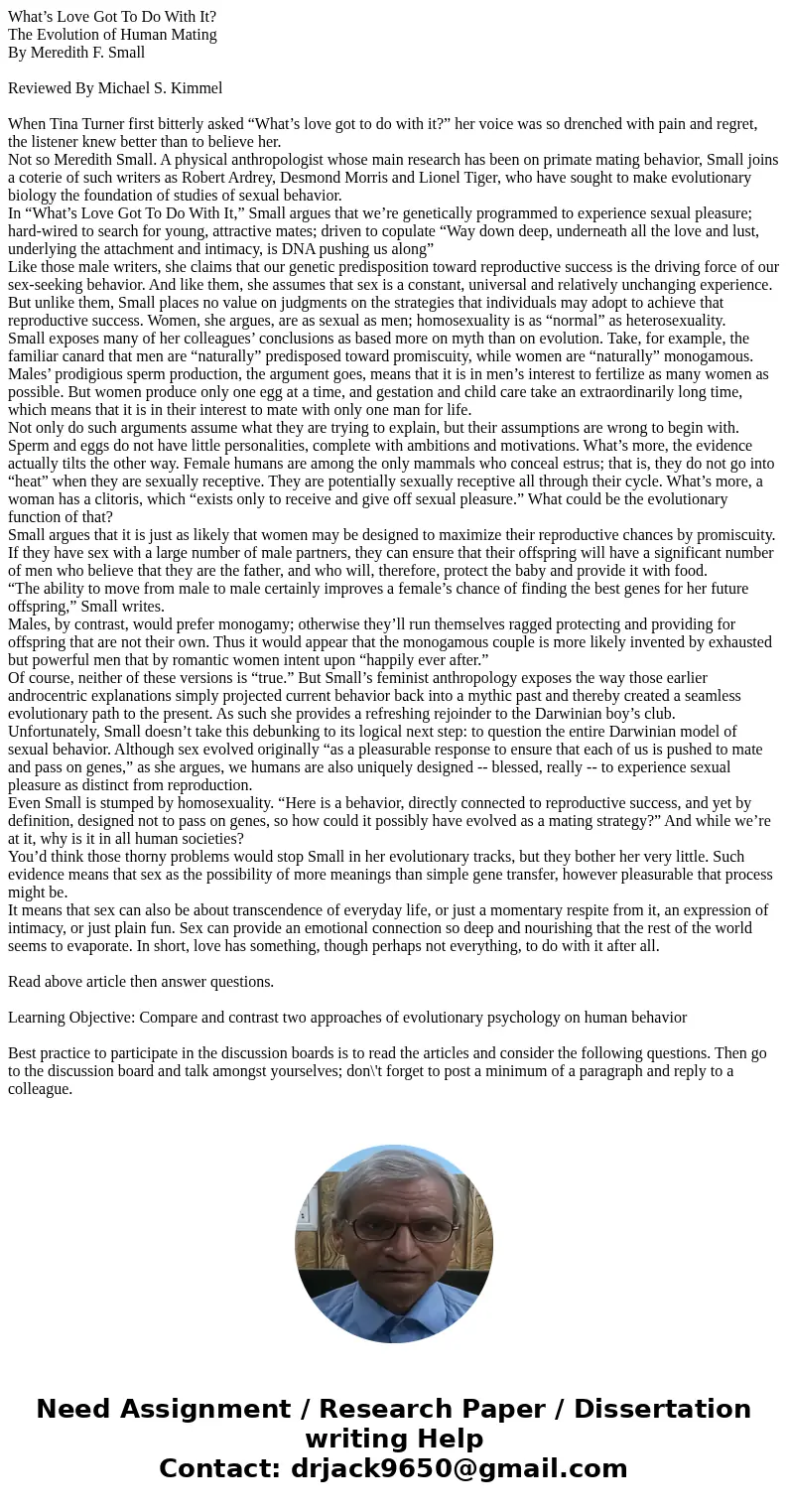
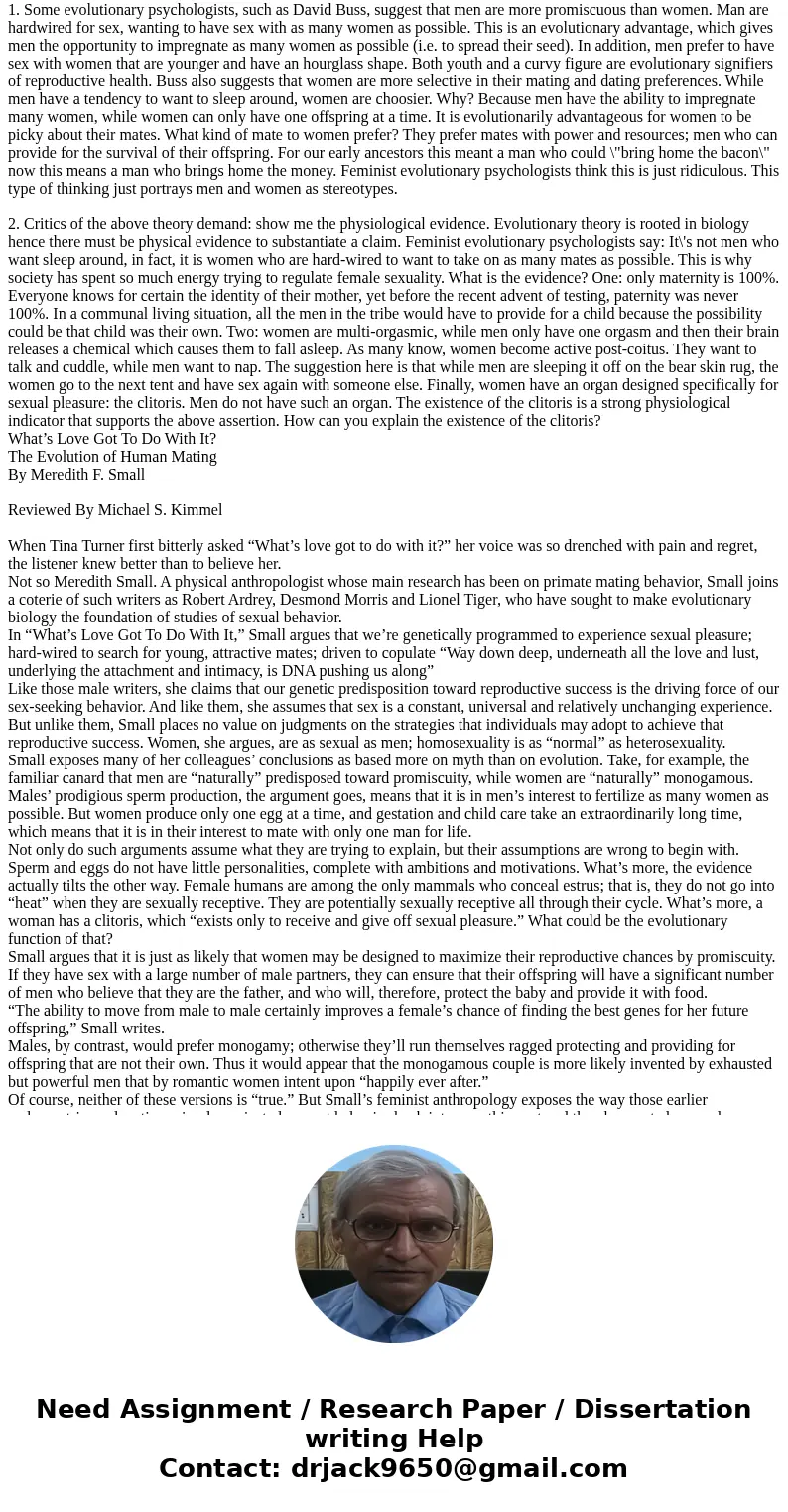
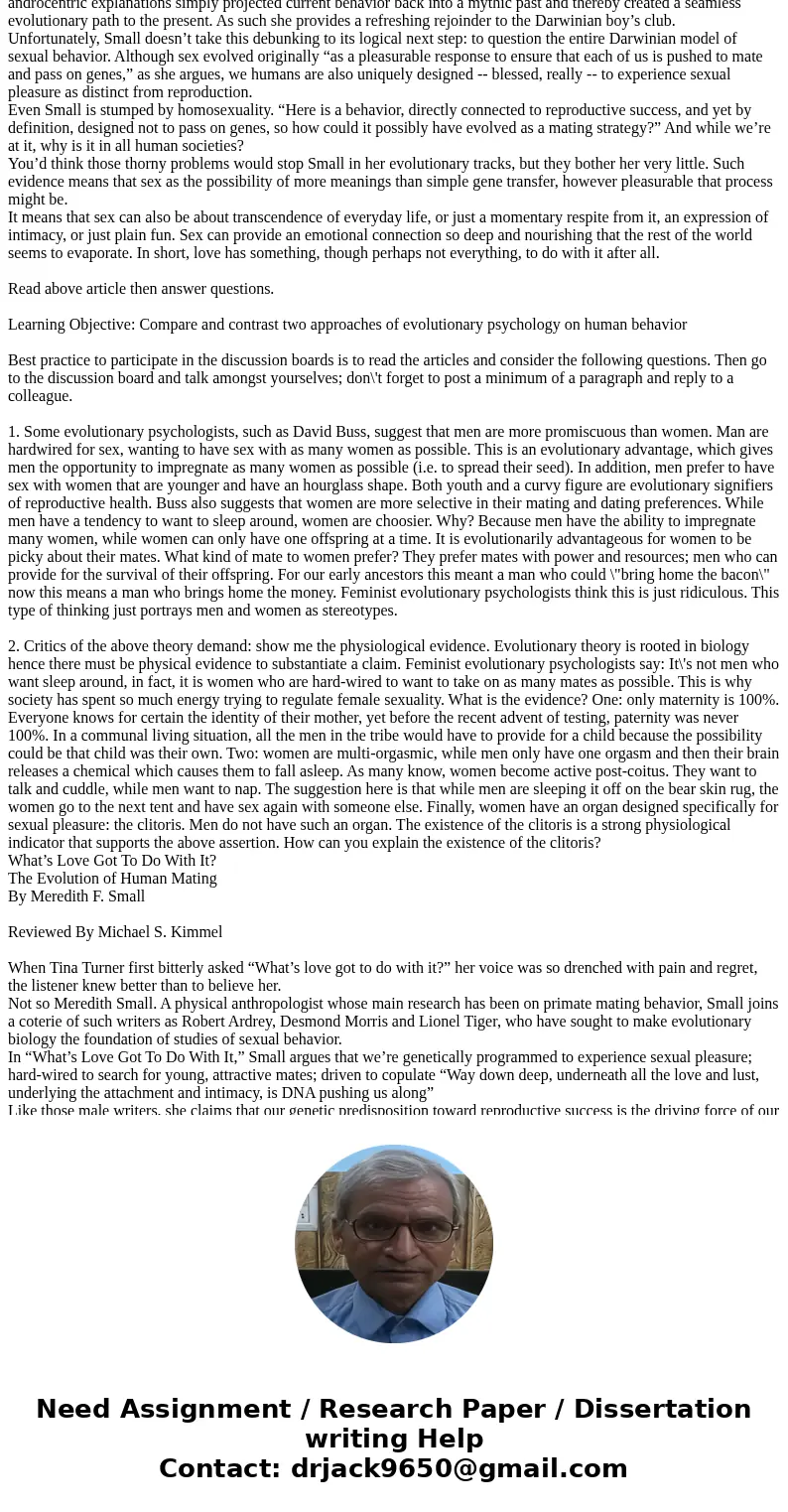
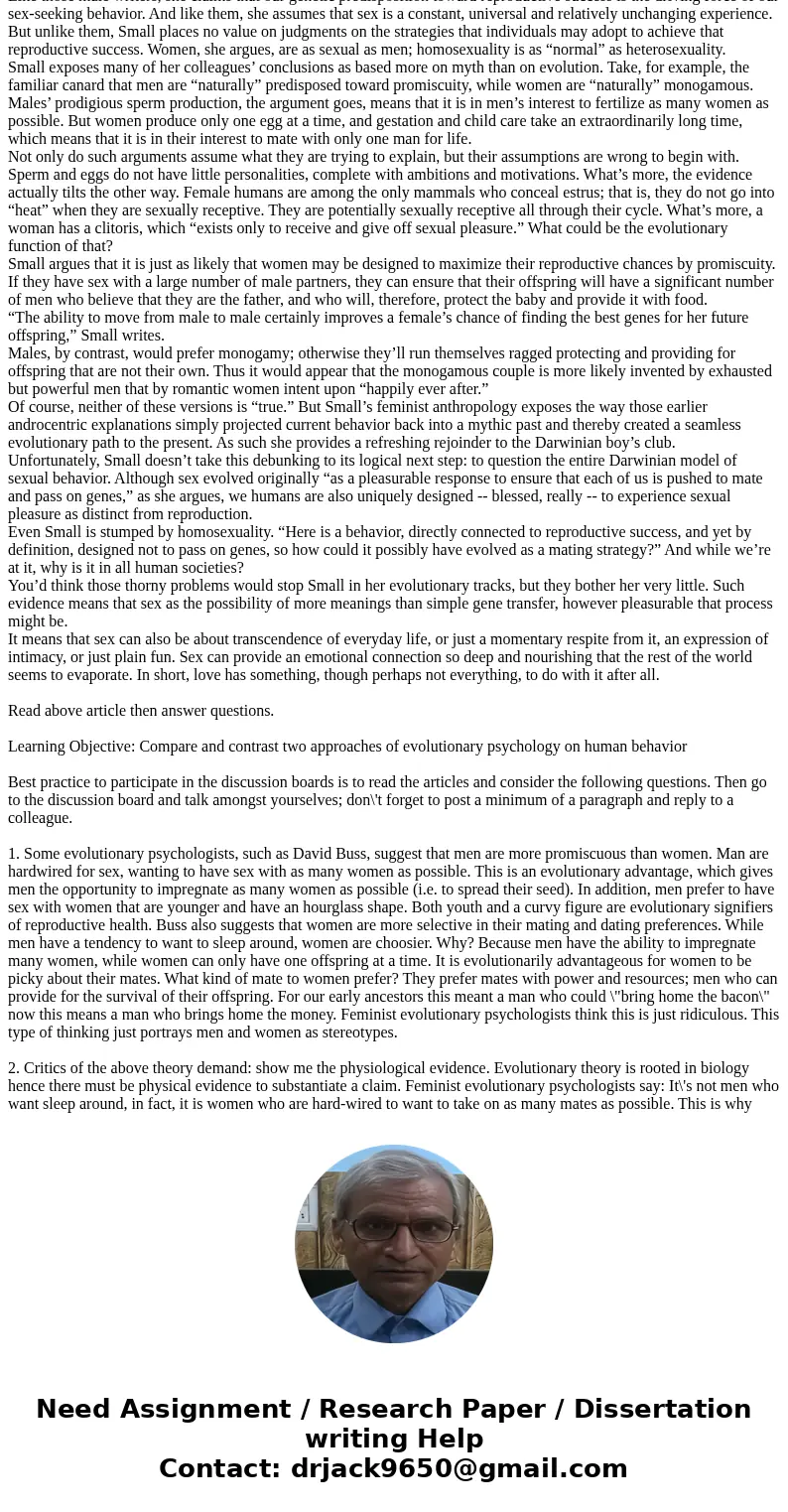
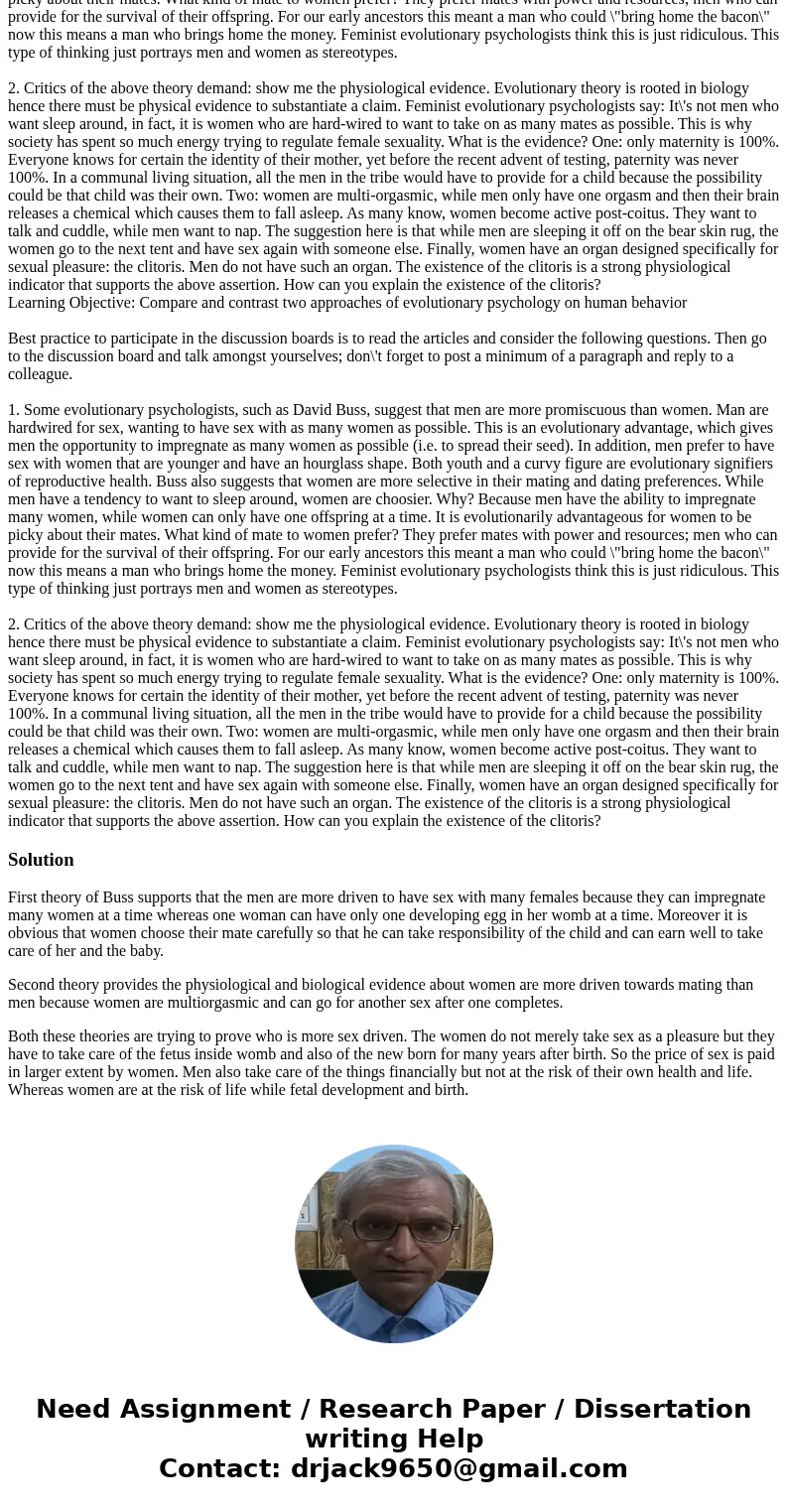
 Homework Sourse
Homework Sourse